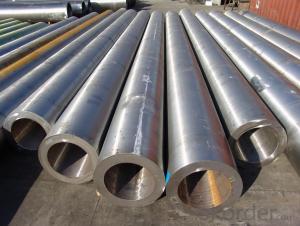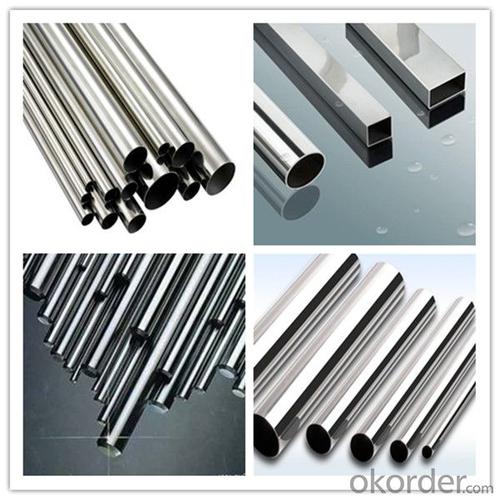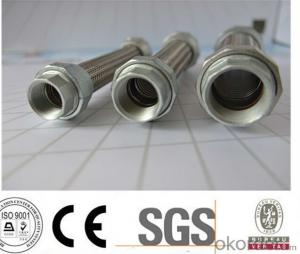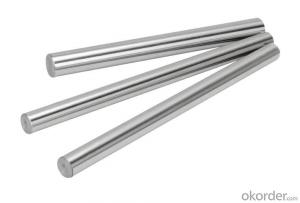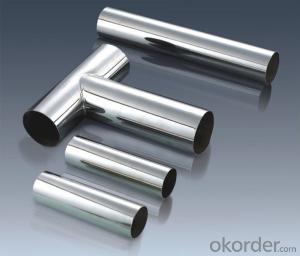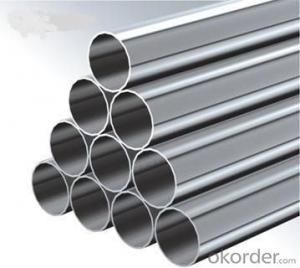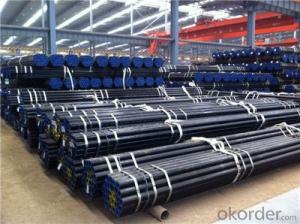304 Stainless Steel Pipe Price with Mill / Slit Edge
- Loading Port:
- Shanghai
- Payment Terms:
- TT OR LC
- Min Order Qty:
- 6 m.t.
- Supply Capability:
- 3000 m.t./month
OKorder Service Pledge
OKorder Financial Service
You Might Also Like
Specification
Product Description
Specification of 304 stainless steel pipe price
1. Material: 300series
2. Standard: JIS, AISI, ASTM, GB, DIN, EN
3. Thickness: 0.3-120mm or as customer’s requirement
4. Outer diameter : 0.6 or as customer’s requirement
5. Length:as customer’s requirement
6. Surface: 2B, BA, No.1, etc
7. Technical processing:Welded or Seamless
8. Decoration:
Mirror, No.4, HL NSP, Bead Blast, Vibration,
HL Gold, Mirror Gold, Vibration Gold NSP,
No4 Copper NSP, Mirror Copper, Bead Copper,
HL Brass, Mirror Brass, Bead Brass,
HL Black, Mirror Black, Bead Black NSP,
HL Bronz, Mirror Bronze, Vibration Bronze,
Mirror Etched, HL Etched Copper, Mirror Black Etched, Mirror Etched Gold.

Surface finish of 304 stainless steel pipe price
2B,BA,HL,SB,BK,NO.1,NO.2,NO.4,NO.8,Polish,PVC,Brush,Mirror,Pickled,Annealed etc.

Mechanical property of 304 stainless steel pipe price
| Tensile Strength | σb (MPa)≥520 |
| Offset Yield Strength | σ0.2 (MPa)≥205 |
| Elongation | δ5 (%)≥40 |
| Reduction of Area | ψ (%)≥60 |
| Hardness | ≤187HB;≤90HRB;≤200HV |
| Density(20℃,g/cm3) | 7.93 |
| Melting Point(℃) | 1398~1454 |
| Specific Heat Capacity(0~100℃,KJ·kg-1K-1) | 0.5 |
| Thermal Conductivity(W·m-1·K-1) | (100℃)16.3,(500℃)21.5 |
| Coefficient of Linear Expansion(10-6·K-1) | (0~100℃)17.2,(0~500℃)18.4 |
| Electrical Resistivity(20℃,10-6Ω·m) | 0.73 |
| Longitudinal Modulus of Elasticity(20℃,KN/mm2) | 193 |
Chemical composition of 304 stainless steel pipe price
| 304 | C | Mn | P | S | Si | Cr | Ni |
| % | ≤0.08 | ≤2.00 | ≤0.045 | ≤0.030 | ≤1.00 | 17.5–20.0 | 8.0-11 |
Maintenance of 304 stainless steel pipe price
(1) Regular cleaning and maintenance
(2) Pay attention to prevent the occurrence of the phenomenon of surface scratches
(3) Use soap, weak detergent or warm water to remove surface dust, dirt
(4) In addition to the surface of the binder with alcohol or an organic solvent (ether, benzene)
(5) Use neutral detergent or ammonia solution in addition to surface oil
(6) With 10% nitric acid or abrasive detergent in addition to the surface of the embroider caused by the dirt.
Packaging & Shipping
Packaging way of stainless steel: Original packaging according to your needs. Standard export sea-worthy wooden packing.
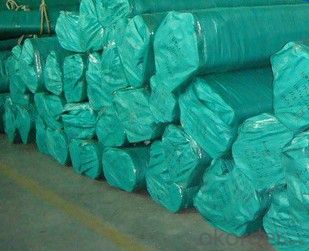
Our Services
1.All product are made of high-quality stainless steel sheet;
2.We have good service & short delivery time;
3.We have professional export team;
4.We can provide sample for your evaluation;
5.We can provide Mill test certificate;
6.Your enquiry will get quickly and efficient response.
1)Our products are high quality and best price.
2)We have experience in this line for many years.
3)We have professional team and the factory.
4)It's very important for a company to be honest in the process of trading and so do we.
5)Our products are exported to countries around the world.
- Q: Can stainless steel pipes be used in the renewable energy industry?
- Yes, stainless steel pipes can definitely be used in the renewable energy industry. Stainless steel is a highly versatile and durable material that offers numerous advantages for various applications in renewable energy systems. One of the key benefits of stainless steel pipes is their exceptional corrosion resistance. This makes them ideal for use in environments where exposure to moisture, chemicals, and other corrosive elements is common, such as in solar power plants, geothermal energy systems, and offshore wind farms. Stainless steel pipes can withstand these harsh conditions and maintain their structural integrity over long periods, reducing the need for frequent repairs and replacements. Another advantage of stainless steel pipes is their high strength-to-weight ratio, which allows for the design of lightweight and efficient renewable energy structures. Stainless steel pipes can be used in the construction of support frames, structures, and pipelines for wind turbines, solar thermal collectors, and biomass power plants, among others. Their strength and durability contribute to the overall reliability and longevity of the renewable energy systems. Furthermore, stainless steel pipes are resistant to extreme temperatures, making them suitable for use in high-temperature applications like concentrated solar power systems. These pipes can handle the intense heat generated by solar receivers without undergoing deformation or degradation, ensuring the efficient transfer of heat in the system. In addition to their mechanical properties, stainless steel pipes are also hygienic and environmentally friendly. They are easy to clean and maintain, reducing the risk of contamination and ensuring the purity of fluids in renewable energy processes. Stainless steel is also a recyclable material, aligning with the sustainability principles of the renewable energy industry. Overall, stainless steel pipes offer a reliable, long-lasting, and cost-effective solution for various applications in the renewable energy industry. Their corrosion resistance, strength, temperature resistance, and environmental benefits make them an excellent choice for transporting fluids, supporting structures, and withstanding the demanding conditions of renewable energy systems.
- Q: How do you protect stainless steel pipes from internal corrosion?
- One effective way to protect stainless steel pipes from internal corrosion is by using corrosion inhibitors. These chemicals are added to the fluid or water that flows through the pipes, forming a protective layer on the inner surface of the pipes, preventing corrosion. Additionally, regular cleaning and maintenance of the pipes can help remove any accumulated debris or corrosion-inducing substances, ensuring their longevity and integrity.
- Q: What are the different types of stainless steel pipes available?
- There are several different types of stainless steel pipes available, including seamless pipes, welded pipes, and duplex pipes. Additionally, stainless steel pipes can be classified based on their grade or composition, such as austenitic, ferritic, or martensitic stainless steel pipes. Each type of stainless steel pipe has its own unique properties and applications.
- Q: 304 stainless steel, welded to seamless difference in what place?
- The seamless tube is made by pressing a hole in a stainless steel billet at a temperature of 2200 degrees F. At this high temperature, the tool steel is made soft and spirally shaped from the hole by stamping and drawing. Thus, the wall thickness of the pipeline is uneven and the eccentricity is high. Thus ASTM allows seamless pipe wall thickness ratio of the wall thickness difference of seamed tube. Through the seamed tube cold rolling plate precision (per roll width is 4-5 feet) made. These cold rolled plates usually have a maximum wall thickness of 0.002 inches. The steel plate is cut into a width of PI D, in which D is the outer diameter of the pipe. Tube wall thickness tolerance is very small, and the entire circumference of the wall thickness is very uniform.
- Q: What is the maximum temperature that stainless steel pipes can withstand?
- The grade of stainless steel used determines the maximum temperature that stainless steel pipes can tolerate. Typically, stainless steel pipes have the capability to withstand elevated temperatures between 1200 and 1600 degrees Fahrenheit (650 to 870 degrees Celsius). Nevertheless, it is crucial to acknowledge that extended exposure to these extreme temperatures can weaken the stainless steel, potentially leading to deformation or failure. To determine the maximum temperature limits for a specific grade of stainless steel pipe in a particular application, it is always advisable to refer to the manufacturer's guidelines or consult with a materials engineer.
- Q: Can stainless steel pipes be insulated with polyphenylene sulfide?
- Yes, stainless steel pipes can be insulated with polyphenylene sulfide (PPS). PPS is a high-performance thermoplastic that offers excellent thermal and chemical resistance properties. It can be used as an insulation material for various applications, including pipes and tubing. When applied as insulation on stainless steel pipes, PPS can help in reducing heat transfer and preventing condensation. Additionally, PPS is also resistant to many chemicals, making it suitable for use in corrosive environments.
- Q: What is the cost difference between stainless steel and other types of pipes?
- The price variation between stainless steel pipes and other pipe types can differ based on several factors. Compared to PVC, copper, or galvanized steel, stainless steel pipes generally have a higher cost. This is mainly due to the exceptional qualities and characteristics that stainless steel provides. Stainless steel possesses a high resistance to corrosion, enabling it to withstand harsh environments and chemicals without deterioration. This durability results in an extended lifespan, reducing long-term maintenance and replacement expenses. Furthermore, stainless steel is renowned for its strength and ability to withstand high temperatures, making it suitable for a wide range of applications, including industrial and sanitary purposes. In contrast, other pipe types like PVC or copper are typically more affordable in terms of initial costs. However, they may have limitations regarding durability, chemical resistance, and temperature tolerance. For instance, PVC pipes may crack or break under extreme temperatures or exposure to specific chemicals. Although copper pipes are durable, they can be more expensive than PVC but still less costly than stainless steel. Therefore, when considering the price difference between stainless steel and other pipe types, it is crucial to consider the long-term benefits and potential cost savings associated with stainless steel's superior performance and longevity. Ultimately, the most cost-effective option for any given project or system will depend on the specific application, required qualities, and budget constraints.
- Q: Stainless steel pipe drilling?
- Stainless steel itself is not high hardness, but it is difficult to processing reasons:Because the stainless steel contains C element is low, hardness is not high, and not easy to deformation, plasticity is poor, this is the iron and steel organization grain concentration caused by. This allows the drill to increase its viscosity when drilling, and it is not easy to chip out. The drill is easy to burn at this time. Through the practice comparison, we know that the opening of 135 degree bit is much easier when the control speed is 300-500 to /min. It is much easier than the drilling of 118 degree hole on the same material.
- Q: How do you pressure test stainless steel pipes?
- To pressure test stainless steel pipes, you can use various methods, such as hydrostatic testing or pneumatic testing. Hydrostatic testing involves filling the pipes with water or another suitable liquid and pressurizing them to a specified level using a pump. The pressure is then maintained for a designated period to check for any leaks or failures. Pneumatic testing, on the other hand, involves using compressed air or gas to pressurize the pipes and conducting similar leak detection procedures. It is crucial to follow industry standards, guidelines, and safety measures while performing these tests to ensure the integrity and reliability of the stainless steel pipes.
- Q: Stainless steel pipe pickling ratio
- Usage: used for contaminant removal of various types of stainless steel parts, sheet metal surface and its equipment rust, oxide skin, after welding of yellow blue black spot welding, a silver white metal surface cleaning, and surface passivation, corrosion resistance of stainless steel.
Send your message to us
304 Stainless Steel Pipe Price with Mill / Slit Edge
- Loading Port:
- Shanghai
- Payment Terms:
- TT OR LC
- Min Order Qty:
- 6 m.t.
- Supply Capability:
- 3000 m.t./month
OKorder Service Pledge
OKorder Financial Service
Similar products
Hot products
Hot Searches
Related keywords

